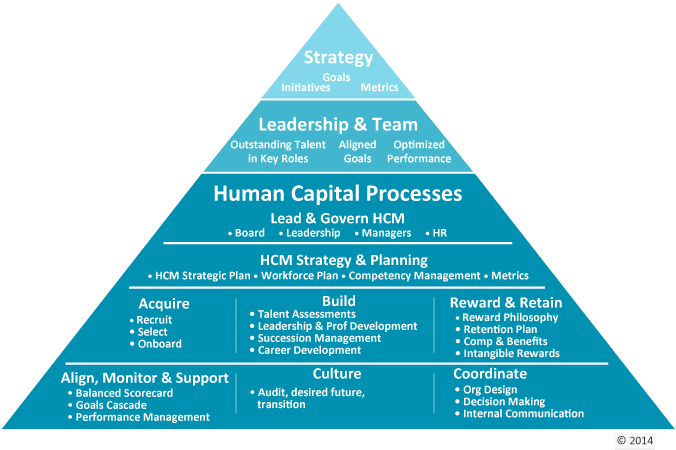For-profit organizations have been strategically managing their talent for years. Through expensive trial and error, IBM, GE, American Express, and others have developed robust human capital management practices to build talent pipelines and develop leaders to increase their business value. Yet, in the nonprofit sector, human capital management is a relatively new concept. "Even more so than in for-profits, where there are hard assets like plants and equipment, a nonprofit really only has staff who are working towards its mission, which is all the more reason to focus on [human capital management]," says AchieveMission Partner Mike Markovits. So why aren't nonprofits using more human capital management practices?
More by AchieveMission
Measuring the ROI of Human Capital Management by James Shepard, CEO and Co-founder, AchieveMission
In this Q&A, Markovits (previously in charge of Leadership globally at IBM, and Leadership and Executive Development at GE) and AchieveMission's Board Chair Tom Eddington (former owner at Hewitt Associates and vice chair at the Taproot Foundation) reflect on their extensive experience in human capital management in both the for-profit and nonprofit sectors. They shed light on why nonprofits are not yet taking full advantage of lessons learned in the for-profit sector and where they see opportunity for nonprofits to do so.
In your experience, what challenges are nonprofits facing in their efforts to become better at human capital management?
Mike Markovits: There are two parts of human capital management that seem to challenge nonprofits more often than the corporations I've worked with.
One part is actually recognizing how important and critical focusing on human capital management is to the accomplishment of their missions. In contrast, at GE and IBM the importance of human capital was reflected throughout the organization: in hiring, evaluations, promotions, and in the way the leadership spent its time. It was not unusual to see senior leaders, including the CEO, spending 30 to 50 percent of their time on human capital issues. It was part of the culture. Companies began to invest in human capital when they realized that not doing so would actually be the more expensive and risky path forward; many nonprofits are just now having that realization for the first time, and it takes time for that shift in priorities to work its way through the organization.
Second, and not surprisingly given the first, nonprofits are generally not aware of the many lessons corporations have learned about how to do human capital management better and less expensively. For example, at GE we learned that pulling managers out of their jobs, putting them into a cohort-based management training, and then sending them back to their business units was not the most effective method for leadership and professional development. When managers returned to their business units, the organizations had a hard time embracing the new methods the leader had learned. We also found that if the leader didn't actually use a piece of the training within a month or two, the knowledge was mostly forgotten. At most, 30 percent of what the managers learned was remembered and implemented. We had much better results when our development efforts focused on stretch assignments, formal and informal coaching, and highly tailored just-in-time training. There are dozens of practices like these that we have successfully adapted for use by nonprofits and that are readily accessible to, but still largely unknown by, nonprofits.
Tom Eddington: While human capital management can help any sized organization, the biggest impact is likely at those with at least a few dozen employees. Most of the leaders of these larger nonprofits experience human capital management challenges regularly but they may not use those words. They might say that they have lots of first-time managers who don't know how to manage, or that their senior leadership team is not working well together, or that the culture does not support accountability and results. More importantly, they are not aware of the decades of learning and the billions of dollars spent in the for-profit sector finding systematic ways to build stronger leaders, teams, and organizations, nor are they aware of the ways hard-won best practices can be tailored to address nonprofits. As Mike said, there's a huge opportunity to transfer knowledge and experience.
The knowledge transfer has not yet happened for a variety of reasons. One is that, historically, there haven't been a lot of nonprofit leaders who have worked in both the for-profit and nonprofit sectors. Another factor is the absence of human capital management experience on the board of many nonprofits. The board is oftentimes comprised of people with other important skill sets. Lastly, many of the nonprofit HR roles have been scoped and filled by strong administrators who have different, important contributions to make. The end result is that the executive director doesn't have access to this information.
What for-profit practices should nonprofit organizations consider adapting?
Markovits: One practice that has been proven highly effective for professional and leadership development is the 70-20-10 approach to learning: for working professionals 70 percent of learning happens on the job through stretch assignments, 20 percent happens through coaching from colleagues to achieve success in those stretch assignments, and 10 percent happens through formal training. As I mentioned earlier, among nonprofits, I see a tremendous overreliance on training which is the 10 percent—sending people to conferences or to workshops as a solution for development—as opposed to development through experience on the job—the 70 percent. Let's get this person a new job or some new projects, let her develop through that experience. Let's really focus on coaching skills to help leaders develop and give them skills to be able to develop staff. It takes some work for an organization to learn how to use 70-20-10 effectively, but once learned it's less expensive and more effective.
Another practice is succession planning—identifying who is capable of moving to key roles, what the total pipeline is inside (and sometimes outside) the organization to those roles, and developing people to help them achieve their potential. We call it succession-driven development and it fosters much faster learning because it taps into personal aspirations in a very concrete way. Too many nonprofits wait until there is an opening and then react instead of planning and building their talent pipelines on an ongoing basis. (For more on leadership development, see Bridgespan's guide Nonprofit Leadership Development: What's Your "Plan A" for Growing Future Leaders? and the Nonprofit Leadership Development Toolkit.)
Eddington: There are about 25 distinct human capital management practices. (For a case study how on AchieveMission helped a nonprofit employ these practices, see the case study "A Smart Investment in Human Capital: How AchieveMission Helped the Corporation for Supportive Housing Increase Mission Impact.") Mike has referenced strong practices in succession and professional development. Others we have seen successfully adapted for nonprofits and that we use frequently include talent reviews, workforce planning, and performance management. General information on all of them is readily available on the internet and AchieveMission has a quickly growing library of nonprofit tailored resources on its website.
AchieveMission's Human Capital Management Framework

It is still up to the nonprofit leader to adapt those practices, to think about best fit as opposed to a generic best practice. They don't need to recreate the wheel—the wheel's already been created—but they need to tailor it for their unique needs.
To do this, a nonprofit leader should consider what his organization's mission is, the kind of leadership and organization needed to achieve it, and the human capital management practices he'll need as a result.
For example, if your organization is doing something highly innovative and unique, your talent strategy will almost certainly be to develop your own talent: you will likely focus on recruiting lots of highly capable entry-level employees with high potential and devoting outsized attention to professional development with a strong focus on succession-driven development. By contrast, if the capabilities you most need at middle and senior leadership positions are readily available, then you have the option to choose to devote more relative attention to hiring at those senior levels.
Performance management can also be tailored. Some organizations need to devote more attention to performance goal achievement. Others weigh achievement of development as most important. And still others are most focused, at a particular time, on aligning behaviors to the organization's culture. How you tailor and use the tool depends on the needs of the organization and the obstacles it faces in realizing its strategic goals.
To do human capital management best, each of the human capital management processes needs to be tailored to your organization's needs, and integrated with all the other ones so that they all work together.
If a nonprofit is interested in getting better at human capital management, where should it get started?
Markovits: If I was going to generalize about where to get started tactically, I would say it might be around creating really strong individual professional development plans. Great professional development plans depend on getting input from a good performance management process: people need to be getting honest feedback so that they know what their goals are each year, how they are doing in achieving those goals, and know what they need to get better at in order to perform better at their current jobs. (Both free and paid resources covering performance management can be found at the Society for Human Resource Management website and the Harvard Business Review website.) Great professional development plans are also informed by some kind of succession planning exercise, where the organization thinks about what employees have the potential to do and what capabilities they would need to strengthen in order to take on a different or a bigger responsibility. They need to know what they need to learn and get exposed to in order to better position themselves to compete for future jobs. Many people today—and I think it's generational to some degree—are interested in how they can continue to learn and grow, and take on new challenges. Having thoughtful, robust individual professional development plans that have both of those components is the key.
Another answer is that all the tactical programs will not produce meaningful results if people in the organization are just going through the motions—just being compliant so that HR or their bosses will get off their backs. So a great place to start is by changing the culture so that each person in the organization believes that talent is the best way for the organization to achieve its strategic goals. Doing this can be hard but it produces incredibly transformative results.
Eddington: Nonprofits can get started by recruiting to their boards board members from the for-profit sector who have backgrounds in human capital management. Executive directors can also familiarize themselves with human capital management. Consider Jack Welch when he was running GE and all the work he did around creating the leadership development program and putting his emphasis and his time on talent management.1 It can seem impossible, but I know nonprofit executive leaders who similarly spend half of their time on human capital management and have experienced the enormous benefit. (See for example, "The Secret to Transformative Scale: Hire Right.") For executive directors, I would encourage them to take the first step of committing to really understanding what human capital management is and how profoundly it can effect their organizations.
What part does organizational culture play in building human capital practices in nonprofits?
Eddington: For human capital management to have its transformative impact the culture needs to embrace talent. As you walk around the importance of talent in that organization needs to be visible. What might you see? The executive director makes talent a key piece of every management and board meeting. Managers who hire and develop future leaders are visibly rewarded. Staff fully embrace spending time recruiting and are rewarded for doing it well. The organization's strategy and annual operating goals are referred to at least once every week as people focus their efforts to support their achievement. Once the key building blocks of a talent culture are in place, it's much easier to implement and continuously improve each human capital management practice.
Markovits: Tom is absolutely correct. Looking at some steps in that transformation can make it more concrete. For example, building a great team requires setting high standards, discussing performance honestly, and addressing underperformance with compassion and candor. Another example: great leadership development requires the current leadership team to want to develop talent that will become able to take their roles. As you can imagine, in some organizations—either for-profit or nonprofit—the culture makes these practices difficult, while in others these kinds of steps are consistent with the current culture, feel relatively comfortable to do, and successful implementation mostly just requires the right training.




